- Afrikaans
- Albanian
- Amharic
- Arabic
- Armenian
- Azerbaijani
- Basque
- Belarusian
- Bengali
- Bosnian
- Bulgarian
- Catalan
- Cebuano
- Corsican
- Croatian
- Czech
- Danish
- Dutch
- English
- Esperanto
- Estonian
- Finnish
- French
- Frisian
- Galician
- Georgian
- German
- Greek
- Gujarati
- Haitian Creole
- hausa
- hawaiian
- Hebrew
- Hindi
- Miao
- Hungarian
- Icelandic
- igbo
- Indonesian
- irish
- Italian
- Japanese
- Javanese
- Kannada
- kazakh
- Khmer
- Rwandese
- Korean
- Kurdish
- Kyrgyz
- Lao
- Latin
- Latvian
- Lithuanian
- Luxembourgish
- Macedonian
- Malgashi
- Malay
- Malayalam
- Maltese
- Maori
- Marathi
- Mongolian
- Myanmar
- Nepali
- Norwegian
- Norwegian
- Occitan
- Pashto
- Persian
- Polish
- Portuguese
- Punjabi
- Romanian
- Russian
- Samoan
- Scottish Gaelic
- Serbian
- Sesotho
- Shona
- Sindhi
- Sinhala
- Slovak
- Slovenian
- Somali
- Spanish
- Sundanese
- Swahili
- Swedish
- Tagalog
- Tajik
- Tamil
- Tatar
- Telugu
- Thai
- Turkish
- Turkmen
- Ukrainian
- Urdu
- Uighur
- Uzbek
- Vietnamese
- Welsh
- Bantu
- Yiddish
- Yoruba
- Zulu
petroleum tubing coupling
Understanding Petroleum Tubing Couplings Vital Components in Oil and Gas Operations
In the oil and gas industry, the extraction process is complex and requires a variety of specialized components to ensure efficiency and safety. One of the crucial elements in this process is the petroleum tubing coupling. These couplings serve as a connection between segments of tubing, facilitating the flow of hydrocarbons from the wellbore to the surface. This article explores the significance, types, and specifications of petroleum tubing couplings, highlighting their pivotal role in the industry.
What is a Petroleum Tubing Coupling?
A petroleum tubing coupling, often simply referred to as a coupling, is a mechanical device designed to connect two lengths of tubing together. This connection is integral to various operations, including drilling, production, and completion in oil and gas wells. Couplings must ideally provide a tight, secure fit to prevent leaks, which can have catastrophic consequences in terms of both safety and environmental impact.
Types of Petroleum Tubing Couplings
Petroleum tubing couplings come in a few variations, each designed to accommodate specific needs and operational conditions. The main types include
1. Standard Couplings These are the most commonly used couplings, made from seamless carbon steel or alloy steel. They are typically utilized for general purpose applications and are designed to withstand high-pressure conditions.
2. Locking Couplings Locking couplings provide additional security through a mechanical locking mechanism, reducing the risk of disconnection under stress. These are preferred in situations where the forces involved are particularly dynamic, such as in high-production wells.
3. Integral Couplings These couplings are forged as an integral part of the tubing itself, eliminating the possibility of threading issues and enhancing strength. They are usually employed in high-stress applications where maximum performance is necessary.
4. Specialty Couplings Custom-designed couplings are engineered for unique applications where standard couplings may not suffice. This includes couplings designed to handle corrosive materials or extreme temperatures.
petroleum tubing coupling

Material Specifications
The choice of materials for petroleum tubing couplings is critical. Most couplings are manufactured from high-grade steel, often treated to enhance their durability and corrosion resistance. Common specifications include
- API Specifications The American Petroleum Institute (API) sets industry standards for equipment used in oil and gas operations, including couplings. Adhering to these specifications ensures compatibility and reliability.
- Heat Treatment Many couplings undergo heat treatment processes to improve their hardness and strength, thus expanding their life expectancy in demanding environments.
- Coating Options To further enhance corrosion resistance, couplings can be coated with materials such as zinc or epoxy paints. This is particularly important in offshore drilling operations, where exposure to saltwater presents significant challenges.
The Importance of Proper Installation
Correct installation of petroleum tubing couplings is essential for optimal performance. Poorly installed or faulty couplings can lead to leaks, which not only reduce efficiency but can also pose serious safety hazards. Adequate training and adherence to best practices in installation are crucial to preventing mishaps.
Conclusion
Petroleum tubing couplings are unsung heroes in the oil and gas industry, playing a vital role in facilitating the efficient flow of resources from the depths of the earth to the surface. Understanding their types, material properties, and importance in the installation process is essential for industry professionals. As the sector continues to evolve and face new challenges, the development and innovation surrounding these couplings will remain paramount in ensuring safe and effective operations in the extraction of petroleum resources.
-
Tubing Pup Joints: Essential Components for Oil and Gas OperationsNewsJul.10,2025
-
Pup Joints: Essential Components for Reliable Drilling OperationsNewsJul.10,2025
-
Pipe Couplings: Connecting Your World EfficientlyNewsJul.10,2025
-
Mastering Oilfield Operations with Quality Tubing and CasingNewsJul.10,2025
-
High-Quality Casing Couplings for Every NeedNewsJul.10,2025
-
Boost Your Drilling Efficiency with Premium Crossover Tools & Seating NipplesNewsJul.10,2025







